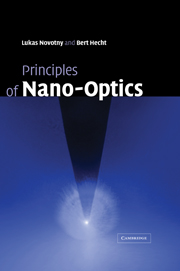Book contents
- Frontmatter
- Contents
- Preface
- 1 Introduction
- 2 Theoretical foundations
- 3 Propagation and focusing of optical fields
- 4 Spatial resolution and position accuracy
- 5 Nanoscale optical microscopy
- 6 Near-field optical probes
- 7 Probe–sample distance control
- 8 Light emission and optical interactions in nanoscale environments
- 9 Quantum emitters
- 10 Dipole emission near planar interfaces
- 11 Photonic crystals and resonators
- 12 Surface plasmons
- 13 Forces in confined fields
- 14 Fluctuation-induced interactions
- 15 Theoretical methods in nano-optics
- Appendix A Semianalytical derivation of the atomic polarizability
- Appendix B Spontaneous emission in the weak coupling regime
- Appendix C Fields of a dipole near a layered substrate
- Appendix D Far-field Green's functions
- Index
15 - Theoretical methods in nano-optics
Published online by Cambridge University Press: 05 June 2012
- Frontmatter
- Contents
- Preface
- 1 Introduction
- 2 Theoretical foundations
- 3 Propagation and focusing of optical fields
- 4 Spatial resolution and position accuracy
- 5 Nanoscale optical microscopy
- 6 Near-field optical probes
- 7 Probe–sample distance control
- 8 Light emission and optical interactions in nanoscale environments
- 9 Quantum emitters
- 10 Dipole emission near planar interfaces
- 11 Photonic crystals and resonators
- 12 Surface plasmons
- 13 Forces in confined fields
- 14 Fluctuation-induced interactions
- 15 Theoretical methods in nano-optics
- Appendix A Semianalytical derivation of the atomic polarizability
- Appendix B Spontaneous emission in the weak coupling regime
- Appendix C Fields of a dipole near a layered substrate
- Appendix D Far-field Green's functions
- Index
Summary
A major problem in nano-optics is the determination of electromagnetic field distributions near nanoscale structures and the associated radiation properties. A solid theoretical understanding of field distributions holds promise for new, optimized designs of near-field optical devices, in particular by exploitation of field enhancement effects and favorable detection schemes. Calculations of field distributions are also necessary for image reconstruction purposes. Fields near nanoscale structures have often to be reconstructed from experimentally accessible far-field data. However, most commonly the inverse scattering problem cannot be solved in a unique way and calculations of field distributions are needed to provide prior knowledge about source and scattering objects and to restrict the set of possible solutions.
Analytical solutions of Maxwell's equations provide a good theoretical understanding but can be obtained for simple problems only. Other problems have to be strongly simplified. A pure numerical analysis allows us to handle complex problems by discretization of space and time but computational requirements (usually given by cpu time and memory) limit the size of the problem and the accuracy of results is often unknown. The advantage of pure numerical methods, such as the finite-difference time-domain (FDTD) method or the finite-element (FE) method, is the ease of implementation. We do not review these pure numerical techniques since they are well documented in the literature. Instead we review two commonly used semi-analytical methods in nano-optics: the multiple multipole method (MMP) and the volume integral method.
- Type
- Chapter
- Information
- Principles of Nano-Optics , pp. 475 - 499Publisher: Cambridge University PressPrint publication year: 2006



